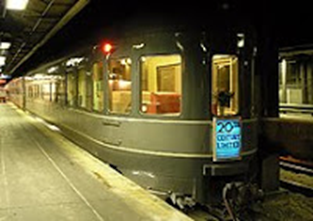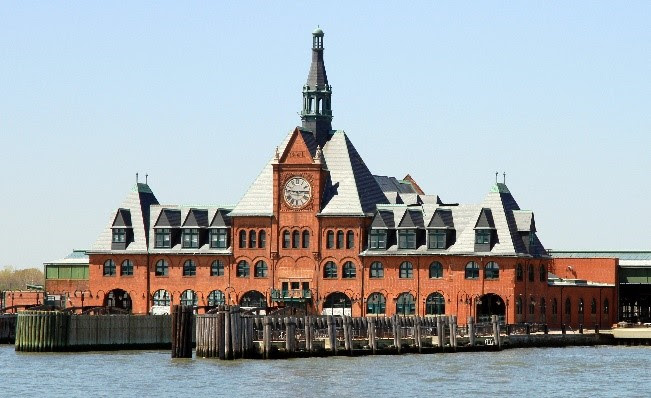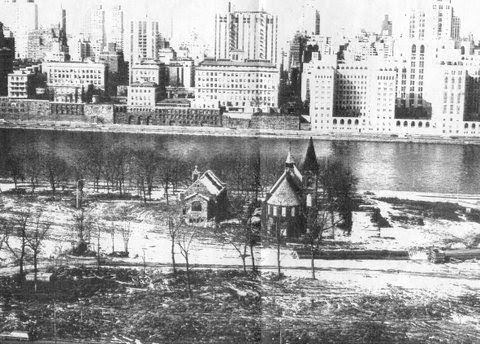Friday, April 2, 2021 – ALL ABOARD FOR TRIP DOWN THE RAIL TRACKS


FRIDAY, APRIL 2, 2021
The
327th Edition
From Our Archives
RAILROADS IN NEW YORK
CITY:
COUNTERINTUITIVE TRUTHS
STEPHEN BLANK

Railroads in New York City: Counterintuitive truths
We New Yorkers deal a lot with steel rails. After all, many of us ride subways or trains every day (or we did “B.C.”). And we were blessed with two of the greatest rail stations in the world, stations which were star performers in many New York novels and films (think of “Twentieth Century Limited”). But our relationships with rails – at least, trains – has been different than one might expect. So sit back, get comfortable and come with me on a tour of counterintuitive New York railroad stories.

Original Grand Central Terminal, NY Times
First counterintuitive truth. Most railroad passengers didn’t arrive in NYC by rail.
All of the trains arriving from the west – even the mighty Pennsylvania – ended at the Hudson River in New Jersey. There, passengers transferred from one of six terminals – Exchange Place (Pennsylvania), Weehawken, Hoboken, Pavonia, and Communipaw – to ferries for the final lap to Manhattan. Trains didn’t come to Manhattan.
Except one. Passengers on the New York Central didn’t have to make the ferry connection. This was Vanderbilt’s great advantage. The Commodore patched together a slew of railroads beginning with what became the Hudson River Railroad (in part surveyed by the renowned civil engineer John Jervis. Yes, the very Jervis we read about who was central in building the Croton Aqueduct and Erie Canal). Vanderbilt also built a connection from Spuyten Duyvil to Mott Haven to connect with another railroad he owned, the New York & Harlem, to get to 42nd Street in Manhattan. In 1869, Vanderbilt changed the name to the New York Central & Hudson River Railroad as he expanded his railroad empire to Chicago. No ferry.
The NY Central enjoyed one of the most beautiful rail passages in the world, along the east shore of the Hudson River (Remember the Cary Grant and Eva Marie Saint seduction scene in the dining car in “North by Northwest”?).
OK. That explains Grand Central. What about Penn Station? The existing situation was horrible. As Diehl writes in The Late, Great Pennsylvania Station, The Pennsylvania trains “came from Philadelphia, Washington, and as far west as Chicago. Together with other roads, they brought passengers from as far south as Florida. Vacationers, tanned and rested wintering in Palm Beach, would leave their well-appointed Pullman cars and stand alongside office clerks commuting to the city as they all waited for ferries to dock.” The other side was worse. No pedestrian bridges crossed West Street and everyone, of every rank, jostled for cabs. And, at times, the Hudson was so enraged that a 15 minute crossing took an hour!
Pennsy’s head, Alexander Cassatt (brother of the impressionist painter, Mary Cassatt) wanted his line to get to Manhattan without ferries. And he wanted a station in New York City that would be truly breath-taking. Long story – which involves relations with Andrew Carnegie, rail rebates, lots of money and so on – relatively short. Cassatt wanted a tunnel but was stymied because steam driven trains in a long tunnel would suffocate everyone, so he opted for a bridge that would be twice as long as the Brooklyn Bridge, across a much more difficult river. He finally found the answer in electrifying the railroad and building a tunnel. And, of course, Penn Station modeled on the Baths of Caracalla in Rome. Even more, Cassatt’s plan was to link the LIEE and Pennsy at the new station, to provide non-stop service from the west to Long Island.
(There’s another railroad story here, too, about the change in 4th Avenue from the worst, dirty, smelly and dangerous avenue in the City to beautiful Park Avenue – which involves the electrification of the railway line up the Avenue. But for another time.)

Jersey City’s Central Railroad of New Jersey Terminal Wikipedia
All right, second Counterintuitive truth. Most immigrants who arrived in New York harbor didn’t come to New York City.
About 70 percent of the 12 million immigrants processed at Ellis Island between 1892 and 1924 were headed to destinations outside New York.
Immigrants were taken by ferry to all of the New Jersey shoreline stations to board trains heading west. Many passed through Jersey City’s Central Railroad of New Jersey Terminal, one of the largest, busiest stations in the region, serving nearly 300 trains a day, whether for passengers or freight. New York-bound commuters from Hudson, Union, Middlesex, Somerset, Warren, Monmouth and Hunterdon counties would pass through the terminal to transfer between the train that brought them from home and the ferry that connected to lower Manhattan.
In a separate waiting room sat a contingent of new arrivals, making a much less routine transfer. The Terminal was the first place they landed after they were approved on Ellis Island to enter the country. Many had purchased their train tickets before leaving home, in a package deal with their ship’s passage, but a ticket office at the Immigration Station was also available for those who still had to plot their course to their new homes. Ferries shuttled them from Ellis Island to the station, where the Baltimore and Ohio offered direct passage to points as far west as St. Louis and Chicago. The Reading Railroad also supplemented the Central Jersey with service to western Pennsylvania and Philadelphia. During the heaviest migration years, entire cars of trains would often be designated solely for immigrants.

Third Counterintuitive truth, the Port of NYC & NJ, the third biggest container port in the country, is basically truck served rather than rail.
The images we have of great container ports are huge ships, enormous cranes, and vast spaces. What’s distinctive about the Port of NY-NJ is the tighter quarters and the dominant role of trucks. Trucks account for moving 85 percent of the containers on and off NY-NJ port terminals. At the first and second largest container ports in the US, Los Angeles and Long Beach (NY-NJ is third), 35 percent of containers are taken by rail directly on the loading dock.
Because a much larger share of goods from the port stay in the New York region than in other major ports, we see more trucks on NYC streets than in most major American cities. About 90 percent of freight is delivered by truck in the City. By contrast, the city’s rail lines transport just 2 percent of New York’s cargo. (Another story – the growing role of trucks in New York freight was one reason for the building of the High Line railroad on the West Side.)
Plans are (were? Before-Covid) underway to reduce the port’s historical heavy reliance on trucks to transport cargo that arrives via ship. This is the ExpressRail system, and culminates a $600 million Port Authority capital investment program dating back to the 1990s that established direct rail access to on-dock and near-dock intermodal rail services at all of its major marine terminals.

One reason is simple. Most goods arriving by rail from the west have to be transferred to truck in New Jersey. That’s part of the reason why we have so many more trucks in the City. Some railroad cars do cross the Hudson, but not by bridge or tunnel. Rather, by barge – or “car float”. Car floats operated between the major railroad terminals on the west bank of Hudson and numerous terminals located in Brooklyn, Queens, Staten Island, the Bronx, and Manhattan. Before the rise of safe, large and inexpensive trucks, this was how New York got its stuff. Today, the New York New Jersey Rail, LLC is a switching and terminal railroad operates the only car float operation across Upper New York Bay between Jersey City and Brooklyn. This operation has been owned by the Port Authority since November 2008, as a step in what was hoped might lead to the creation of a Cross-Harbor Rail Tunnel. Fat chance.

Freight rail does exist in City, but is largely unseen. For example, the New York & Atlantic Railway, a freight train that chugs through Queens and Brooklyn neighborhoods, hauling cars loaded with food, scrap metal, construction materials and even beer. The short-line railroad picks up loads from major freight lines that run down through the Bronx and over the Hell Gate Bridge into Queens, to New York & Atlantic’s cramped rail yard in Glendale. New York & Atlantic then takes the cars and distributes them to businesses along its lines where they are often taken onto tracks leading to a customer’s property. Some trains end up at rail-to-truck hubs, where goods are transferred to trucks for local deliveries. About 15 percent of New York & Atlantic’s rail cars are floated over from New Jersey, but that would grow if the car float system expanded.
I hope this essay didn’t run you off the rails. Thanks for reading.
Stephen Blank
RIHS
March 24, 2021
SOURCES
http://nycshs.blogspot.com/2008/05/nyc-railroad-history.html
https://hvmag.com/life-style/history/hudson-valley-train-travel/ Lorraine B. Diehl, The Late, Great Pennsylvania Station (1996)
FRIDAY PHOTOS OF THE DAY
SEND YOUR SUBMISSION TO:
ROOSEVELTISLANDHISTORY@GMAIL.COM

THURSDAY PHOTO OF THE DAY
MAGNOLIA TREES IN COLER GARDEN
THOM HEYER, CLARA BELLA, ALEXIS VILLEFANE,
RITA MEED, ED LITCHER, JAY JACOBSON, GLORIA HERMAN,
& NINA LUBLI GOT IT.

EDITORIAL
TAKE A WALK TO THE GARDEN JUST NORTH OF THE COLER MAIN ENTRANCE AND ENJOY THE MAGNOLIAS IN FULL BLOOM!
JOYOUS EAST GREETINGS
Text by Judith Berdy
Thanks to Bobbie Slonevsky for her dedication to Blackwell’s Almanac and the RIHS
Thanks to Deborah Dorff for maintaining our website
Edited by Deborah Dorff
Roosevelt Island Historical Society
STEPHEN BLANK
RIHS ARCHIVES
FUNDING PROVIDED BY ROOSEVELT ISLAND OPERATING CORPORATION PUBLIC PURPOSE GRANTS CITY COUNCIL REPRESENTATIVE BEN KALLOS DISCRETIONARY FUNDING THRU DYCD


Copyright © 2021 Roosevelt Island Historical Society, All rights reserved.Our mailing address is:
rooseveltislandhistory@gmail.com

Leave a comment